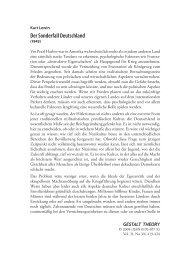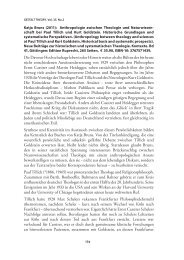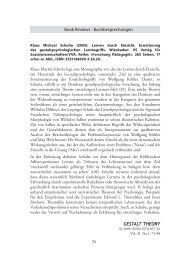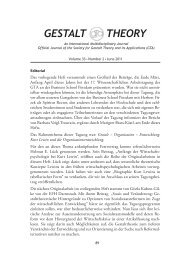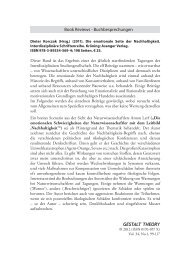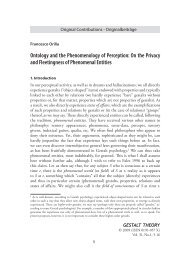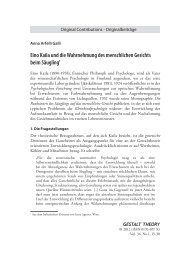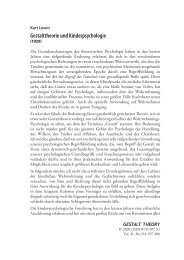What is the Meaning of Shape? - Gestalt Theory
What is the Meaning of Shape? - Gestalt Theory
What is the Meaning of Shape? - Gestalt Theory
Create successful ePaper yourself
Turn your PDF publications into a flip-book with our unique Google optimized e-Paper software.
GESTALT THEORY, Vol. 33, No.3/4<br />
<strong>the</strong> shape, i.e. without <strong>the</strong> rotation <strong>the</strong> square as a singularity could not be<br />
perceived. As soon as <strong>the</strong>y are defined, square and rotation organize <strong>the</strong>mselves<br />
asymmetrically as suggested by <strong>the</strong> two previous descriptions.<br />
! " #<br />
Fig. 2 A square (a), a rotated square (b) and a diamond (c)<br />
3.2.3. Diamond<br />
By increasing <strong>the</strong> rotation <strong>of</strong> Fig. 2b up to 45° as shown in Fig. 2c, both <strong>the</strong><br />
happening (rotation) and <strong>the</strong> square are replaced by ano<strong>the</strong>r one-word description:<br />
a diamond. Th<strong>is</strong> outcome <strong>is</strong> unexpected, if compared with <strong>the</strong> square <strong>of</strong> Fig. 2a.<br />
It represents a hard problem for an invariant features hypo<strong>the</strong>s<strong>is</strong>. In fact, if shapes<br />
are defined by virtue <strong>of</strong> attributes invariant over rotations, <strong>the</strong>n <strong>the</strong> two shapes<br />
<strong>of</strong> Figs. 2a and 2c should be perceived as having <strong>the</strong> same shape. Therefore, <strong>the</strong><br />
square and <strong>the</strong> diamond demonstrate that different shape rotations cannot be<br />
perceived as having <strong>the</strong> same shape.<br />
Figs. 2a and 2c show <strong>the</strong> so-called Mach’s square/diamond illusion (Mach,<br />
1914/1959; Schumann, 1900), according to which <strong>the</strong> same geometrical figure <strong>is</strong><br />
perceived as a square when its sides are vertical and horizontal, but as a diamond<br />
when <strong>the</strong>y are diagonal. From a phenomenal point <strong>of</strong> view, it <strong>is</strong> more correct to<br />
state that <strong>the</strong> square <strong>is</strong> perceived when <strong>the</strong> sides are vertical and horizontal, while<br />
a diamond <strong>is</strong> seen when its angles or vertices are vertical and horizontal. Th<strong>is</strong><br />
description <strong>is</strong> more appropriate if we consider what emerges more strongly in <strong>the</strong><br />
two conditions: <strong>the</strong> sides in <strong>the</strong> case <strong>of</strong> <strong>the</strong> square, and <strong>the</strong> angles/vertices in <strong>the</strong><br />
!"#$%&'()''!"#$%#&'(#$$"<br />
case $%!&'()'&%*'+*!,(,-'./')%!0*1<br />
<strong>of</strong> <strong>the</strong> diamond. We will see in section 5 some important consequences <strong>of</strong> <strong>the</strong>se<br />
phenomenal observations for a better understanding <strong>of</strong> <strong>the</strong> meaning <strong>of</strong> shape.<br />
One main effect related to Mach’s square/diamond illusion <strong>is</strong> <strong>the</strong> fact that <strong>the</strong><br />
diamond appears larger than <strong>the</strong> square. Schumann (1900) suggested that th<strong>is</strong> <strong>is</strong><br />
related to <strong>the</strong> fact that v<strong>is</strong>ual attention <strong>is</strong> placed on <strong>the</strong> vertical-horizontal axes,<br />
which are clearly longer in <strong>the</strong> diamond condition. Th<strong>is</strong> explanation <strong>is</strong> supported<br />
by <strong>the</strong> results <strong>of</strong> a simple control experiment according to which, by focusing<br />
<strong>the</strong> attention on one side <strong>of</strong> <strong>the</strong> diamond ra<strong>the</strong>r than on one angle, during <strong>the</strong><br />
compar<strong>is</strong>on <strong>of</strong> <strong>the</strong> size <strong>of</strong> Fig. 2a and 2c, <strong>the</strong> apparent size difference between <strong>the</strong><br />
square and <strong>the</strong> diamond <strong>is</strong> strongly reduced or even annulled.<br />
390





